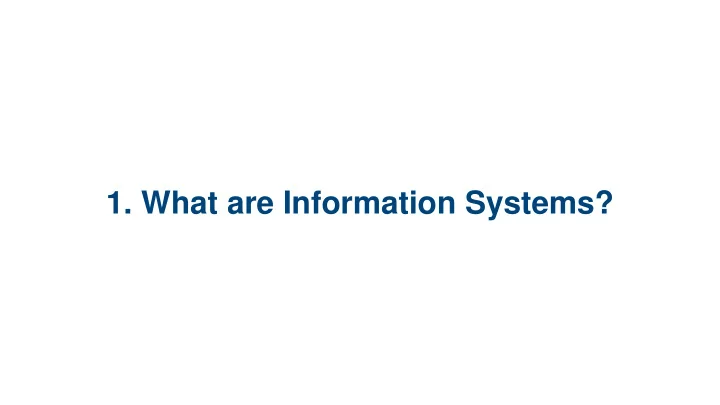

1. What are Information Systems?
1.1 Introduction to Information Systems 1.2 What Is Information? 1.3 Key Elements of Information Systems
1.4 History of Information Systems 1.5 Information Systems Today 1.6 What We Mean by “Digital”
1.1 Introduction to Information Systems
The combination of tools and people who come together to manage information
Elements of Information Systems People Technology Process Data
Elements of Information Systems People Technology Process Structure
Elements of Information Systems The people who The hardware and use and maintain software that are the system in use in the IS The rules and The information relationships that fills the system between IS elements as raw material
Technology • Hardware includes telecommunications • Software includes apps, OS, and data base systems
Process is often embedded into software as well as being rules followed by people
Information Systems Does not include the people who invent/create the software nor those who design and build the hardware
1.2 What is Information?
Information Data that has been organized and integrated. • Wisdom • Knowledge • Awareness • Understanding
Elements of Information Systems People Technology Process Data
Data integrity is the overall completeness, accuracy and consistency of data. This can be indicated by the absence of alteration between two instances or between two updates of a data record, meaning data is intact and unchanged.
Data redundancy is a condition created within a database or data storage technology in which the same piece of data is held in two separate places.
Meta-Data • Data about other data - used to develop processes for IS
Information • Information Systems are not Information technology.
1.3 Key Elements of Information Systems
People Those who use and maintain the IS. The only part of the IS that can break the rules
Technology Hardware and software. The part that everyone recognizes as IT
Process The rules and relationships within the operation of the IS. Tell us how to use the system
Data The facts that your IS collects, stores, and analyzes to produce useful information
Information Systems • All information systems use these 4 elements but not all in the same way.
1.4 History of Information Systems
Analog - Uses a measurable factor (analog) to represent specific data Digital - Converts all data into digital bits
Analog Devices - Abacus, slide rule, or vinyl records - Limited ability to manipulate or store data
Slide Rule - Analog computer of 1950
Early Mainframe Computers Huge, slow, and expensive. No available software and Limited storage for data
Data The most common storage method was the Hollerith (IBM) punch card
Telecommunications The only way to manage complex connections between users was human operators
The history of IS is the increase in speed, storage, and the ability to exchange data across many users
1.5 Information Systems Today
All data is stored and manipulated digitally. Analog data from the real world (sounds, images, instrument readings) is converted to digital data.
Moore’s Law Computer processing speeds will increase at an exponential rate, doubling every 2 years
Computer Speed 25 20 15 10 5 0 1 2 3 4 5 6 7 8 9 10 11 12 13 14 15 16 17
Modern Computers Fast, interconnected, and using standard software. Everything seems to be a computer today
Data Storage Storage density and speed also described by Moore’s law. Most data on Earth stored in Info systems
Telecommunications Most young people in the US today have never used a rotary dial phone and seldom spoken to a telephone operator
Networking Ability to connect different elements of the IS continues to increase. • Wireless • Satellite • Broadband • The Internet
What looks amazing to us is commonplace to our children and primitive to our grandchildren
1.6 What We Mean by “Digital”
Digital data is expressed in Radix 2 - “Base 2” All data is a 1 or a 0 People normally use base 10, because we have 10 fingers to count on.
The Number 128 in Base 10 100s / 10s / 1s 1 2 8 (1x100) +(2x10)+(8x1)
The Number 128 in Base 2 128s / 64s / 32s / 16s / 8s /4s / 2s / 1s 1 0 0 0 0 0 0 0 128 Base 10 = 10000000 Base 2
1s and 0s are easy to describe electronically 1 0 1 0 0 0 0 0 0 0
Digital information can be easily stored and manipulated electronically.
Digital networks can process all kinds of data - sound, video, text, numbers, etc, because it can all be converted into strings of digital bits
• A single 1 or 0 = 1 Bit • 8 Bits = 1 Byte • 1 million Bytes = 1 Megabyte • 1 billion Bytes = 1 Gigabyte • 1 trillion Bytes = 1 Terabyte 1 Byte can describe 255 characters (11111111) All letters, numbers, and punctuation in English
Digital information and information systems can be analyzed using Boolean Algebra
Recommend
More recommend